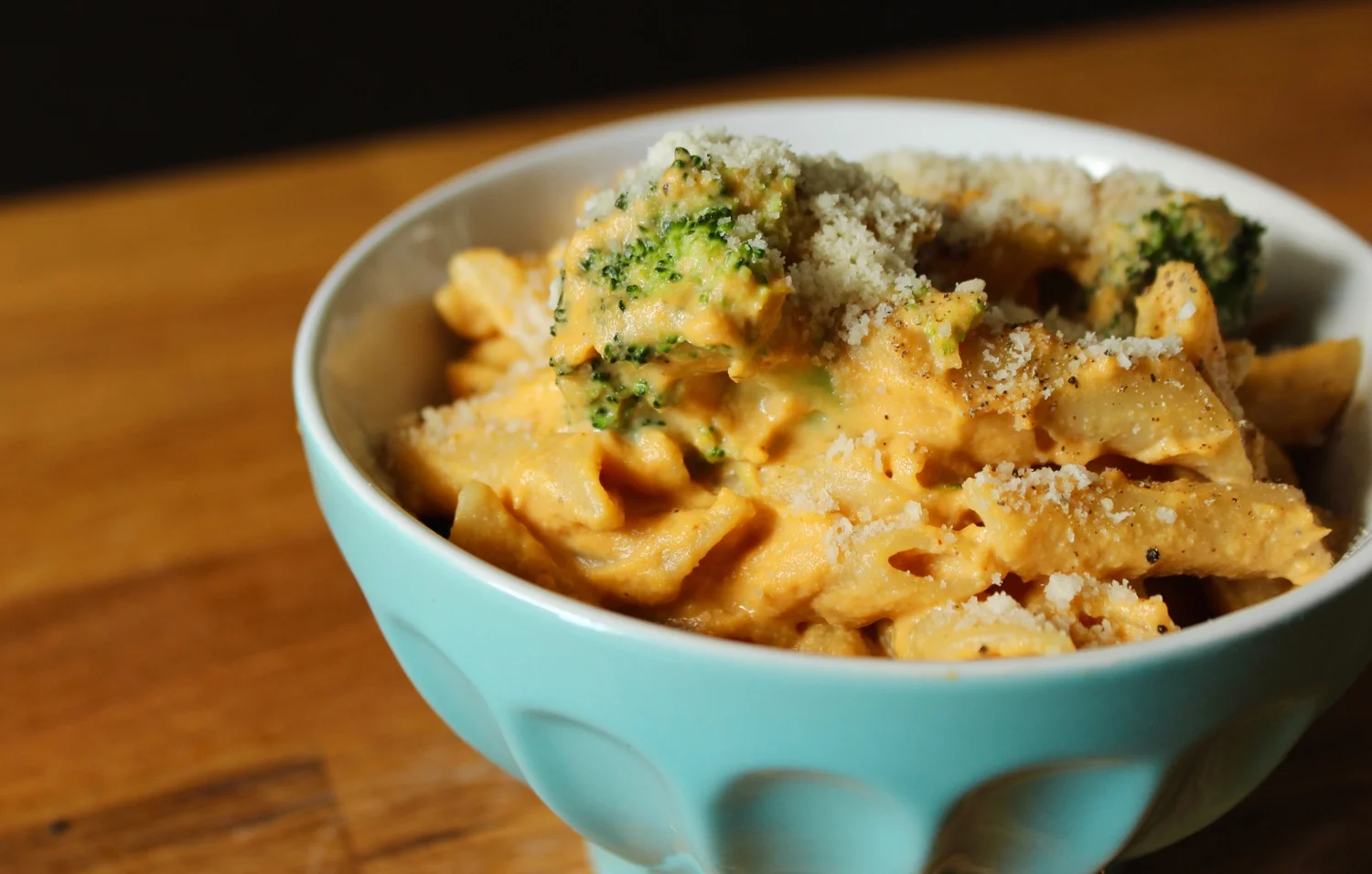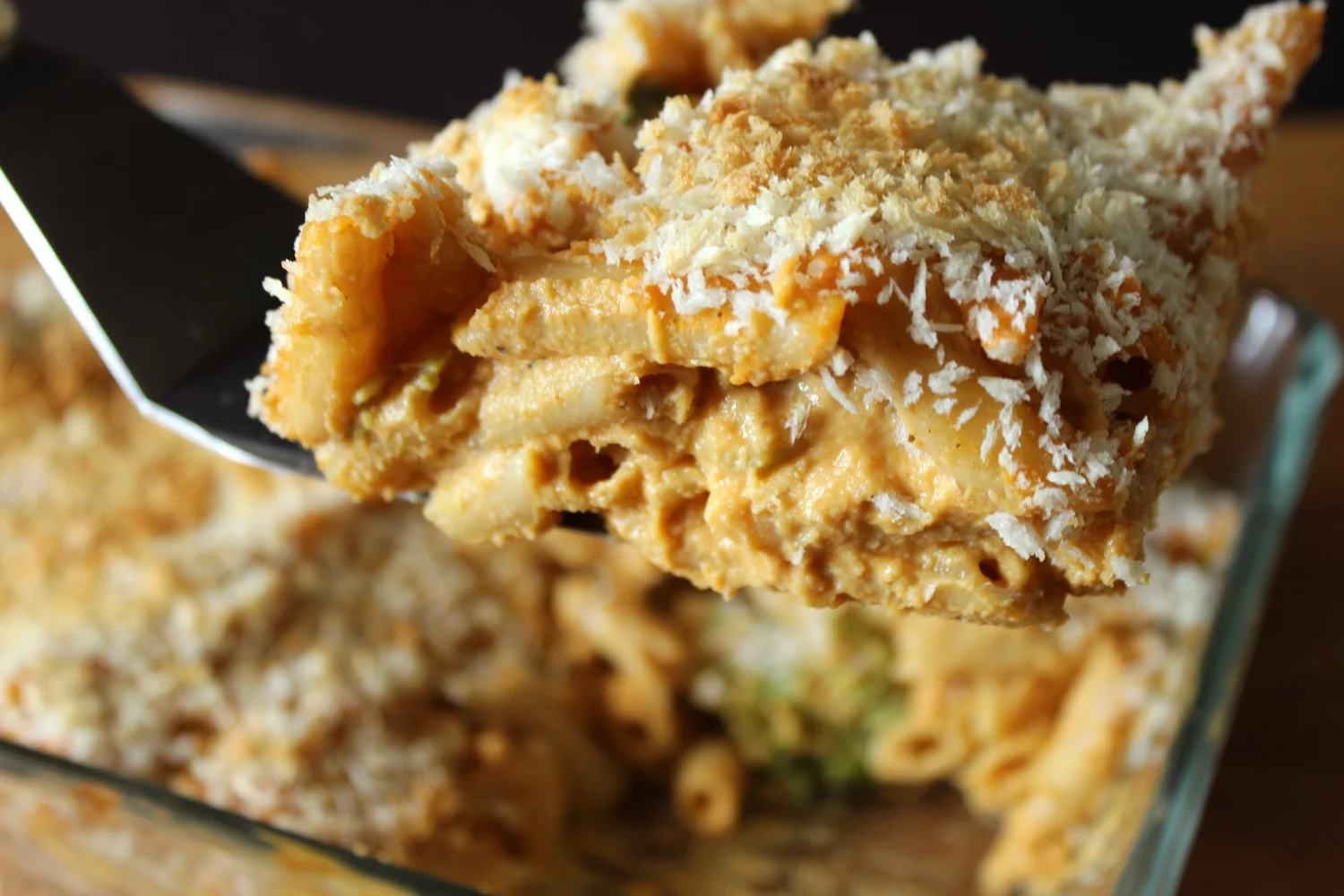
Last week was dedicated to teens who are trying to make more vegan choices or have gone vegan when perhaps their family doesn't want to make this change. It got me thinking about my teenage years and how even when I started cooking, opening a box of mac and cheese and ripping open that cheese powder packet gave me such a thrill. Even though I could already make delicious treats, mac and cheese was one of my favorite foods, and I had an endless supply of the boxed stuff in the pantry. Nowadays you can even find the same boxed equivalent, orange packet and all, in its vegan version, but in case you're like me, and you live in an area where some of these products aren't available, or you simply want to make it at home, today we're having a vegan mac and cheese architecture class!
Yup! Vegan mac and cheese architecture is a thing!
There are so many mac and cheese recipes out there that you can follow to get great results, but you know me and how my teacher brain works. I have to teach you the basics so that you can understand mac and cheese, breathe mac and cheese, cook mac and cheese, love mac and cheese. Yes, we're doing it without dairy cheese, and also in many cases without the vegan kind either! Just in case you don't have access to them, they're out of your budget or you don't have any in the house when a vegan mac attack hits you like a ton of bricks.
There are so many ways to make vegan mac and cheese, and today I'm going to teach you some basics so that you can feel inspired to create your recipes at home, or just whip up a batch without measuring anything (my favorite way of cooking because you don't have to wash the measuring cups at the end!)

Mac and cheese architecture 101
We need the right kind of pasta
Aka, one that can hold a bit of the sauce so that when you bite into it you get that burst of cheesy creaminess. Yum! Macaroni is of course the traditional choice, but I also love elbow pasta, penne pasta, shells, etc. Any short pasta that is hollow and allows for some of the sauce to hide in there and come out and yell "surprise"! Now you can find many gluten free varieties of pastas if you have a gluten intolerance and even pastas made from lentils and beans! Any type you love that is hollow will do.
We need ingredients that will provide a creamy base
As you'll see below in the options I'm going to give you, you need one or several ingredients (these can range from vegetables to pre-soaked cashews or other nuts and seeds) that once cooked or soaked can be blended up to provide the cream base for your mac. In some cases, a simple roux will give you a creamy base, and I'll give you all the scoop of what that is below.
We need nutritional yeast
Nutritional yeast is a deactivated form of yeast that you can find in many supermarkets or stores these days or order online. It has a wonderful naturally cheesy flavor, a yellow color and a massive boost of vitamins, minerals and protein. Basically, the person who discovered it deserves a few gold stars. Although you can make mac and cheese without it, it really makes a difference, adds that delicious cheesy flavor, and it provides lots of nutrition. Even some vitamin B12 in the case of some brands!
We need a liquid
A liquid will help to either create a roux (more on this below), or it will help blend up our vegetables, nuts or seeds used for the creamy base. This liquid can be anything from water, veggie broth, non-dairy milk and even some of the pasta cooking water.
We need seasonings and spices
Just as with traditional mac and cheese, we need spices and seasonings to make our mac and cheese taste really savory and satisfying. Some favorites of mine are salt, black pepper, white pepper (works really well with mac and cheese), onion powder, garlic powder, mustard powder, paprika, cayenne pepper, nutmeg, lemon juice, tomato paste, dijon mustard, tamari soy sauce or liquid aminos and agave or some kind of sweetener (for some recipes). Start experimenting with different combinations until you find your favorites.
We need a topping if going the casserole route
Those of us who grew up on mixing together the boxed stuff and grabbing a fork, might not know that many people love the casserole version of mac and cheese. In this version, after your mac and cheese is ready and mixed with the sauce, it is placed in a casserole dish, topped with some good crunchy stuff and popped in the oven until browned and gooey. Some great toppings are panko breadcrumbs, regular breadcrumbs, ground almonds mixed with sea salt, and even some béchamel or grated vegan cheese that gets bubbly and stretchy in the oven. These are all optional, it depends on how you like your mac!
Sorry, but we need little trees
Ok, ok, I'm not here to ruin the cheesy fun, but let's add a little boost of calcium in the form of broccoli florets! Not only because of their nutritional benefits but because mac and cheese is better with broccoli! Alternatively we can also use brussels sprouts, but the broccoli just works! Simply add it to the pasta while it's cooking when it's almost done, and drain everything together. Boom! Calcium boost and lots of little crevices where the cheese can hide and come out at the perfect moment.

All roads lead to mac and cheese heaven
Let's go over the many options and routes we can take when we want to create mac and cheese at home (other than buying the boxed stuff which is of course also an option when you're pressed for time).
The French invented mac and cheese without knowing it: The roux and cheese technique
A roux is one of those things next to croissants we can thank the French for. It's a fancy way of talking about a combination of flour and fat to begin a recipe that you wish to thicken. It's the way we start stews and most gravies and sauces, and of course it's the quickest and easiest of the vegan mac and cheese methods.
- You start by melting some non-dairy butter in a pan, add flour, stir frequently to cook the starchy flavor off, and add a liquid while whisking vigorously (it can be non-dairy milk, vegetable broth, water or a combination).
- Then you add any seasonings you like, nutritional yeast, and you may add some vegan cheese shreds until melted if desired. Let the mixture thicken until creamy, toss with your pasta and serve.
- A great recipe to try: Chef Chloe's super simple mac and cheese
Sweet potato or butternut squash mac and cheese
In this method, sweet potatoes, pumpkin or butternut squash will serve as the base for our creamy texture.
- You start by cooking the sweet potato, pumpkin or butternut squash either by steaming or roasting to retain the most flavors, and you add it to a blender.
- Blend with a liquid (as much as you need to get a rich creamy consistency), nutritional yeast and the spices or seasonings you've chosen (see my favorites above).
- Add back to a pot to warm through and toss with the pasta.
- A great recipe to try: Chef Chloe's sweet potato mac and cheese
Cashew mac and cheese
This method uses cashews you've soaked in water the night before or for at least 4 hours (you can omit this waiting time if you have a high-powered blender like a Vitamix, or if you boil the cashews for 10 minutes).
- You start by pre-soaking your cashews as mentioned above, draining them from this liquid and adding them to a blender.
- Add your liquid (non-dairy milk, water, vegetable broth etc) until a creamy consistency is reached and the cashews are completely pureed and smooth).
- Add this to a pot to warm through, add the nutritional yeast, the seasonings and spices you've chosen and toss with your pasta.
- A great recipe to try: Butternut squash (and cashew) mac and cheese by Veggie Inspired Journey, and our very own creamy mac and cheese for members of our online vegan cooking program!
What's easier (and cheaper!) than carrots and potatoes?!
Just as we did with the sweet potatoes and butternut squash, this option is even simpler because it's made with two ingredients we almost always have in the kitchen: carrots and potatoes.
- We start by steaming or boiling our carrots and potatoes (don't go overboard with the amount of carrots as the flavor can overpower the dish, these are simply meant to add extra nutrients and color).
- Add them to a food processor or blender along with your liquid of choice, nutritional yeast, a bit of tomato paste, lemon juice and your favorite spices and seasonings.
- Warm it up in a pan and toss with the pasta.
- A great recipe to try: Creamy Vegan Mac and Cheese by Vegan Yumminess
Cauliflower mac and cheese
Just as we did with our previous veggie based creams for mac and cheese, cauliflower will be the base in this method.
- We start by cooking the cauliflower until tender (my favorite method is roasting as the flavors really pop).
- Add the cooked cauliflower to a food processor.
- Add your liquid of choice, spices and seasonings, nutritional yeast and blend.
- Warm up and toss with the pasta.
- A great recipe to try: Vegan Richa's black pepper mac and cheese, or, Vegan Cauliflower mac and cheese by vegan insanity
Quick and easy using vegan cheeses
If you have some vegan cheese at home, mac and cheese can be as simple of blending together some ingredients and adding tons of flavor in the form of aromatics, spices, and additions like chillies, garlic, peppers, or anything you like (or plain old classic style!)
- We sweat some garlic in a pan, add non-dairy milk and a slurry of either cornstarch or arrowroot powder and a bit of water. Along with the seasonings, nutritional yeast, spices and additions of your choice.
- We cook until the sauce has thickened a bit.
- Add grated vegan cheese (cheddar style and parmesan style work great because they have the strongest flavors).
- Once melted, we blend the sauce in a blender to make sure it's creamy and very smooth.
- Toss with your pasta and enjoy!
- A great recipe to try: the best vegan gluten-free mac and cheese recipe by Minimalist Baker
So many delicious options to choose from to start making mac and cheese at home.
What kind of mac and cheese did you enjoy eating as a kid? Do you have a favorite way of making this dish in its vegan version? Leave us your comments below!
🧑🍳
You might also like...
Our Online Cooking School and Courses
Don't miss our weekly goodies!
Our best FREE content straight to your inbox


